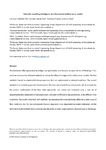Hydraulic modeling of bridges in two-dimensional shallow water models

Use este enlace para citar
http://hdl.handle.net/2183/35605Colecciones
- Investigación (ETSECCP) [826]
Metadatos
Mostrar el registro completo del ítemTítulo
Hydraulic modeling of bridges in two-dimensional shallow water modelsFecha
2022Centro/Dpto/Entidad
Enxeñaría da Auga e do Medio Ambiente (GEAMA)Cita bibliográfica
Cea, L., Vila, G., García-Alén, G., Puertas, J., & Pena, L. (2022). Hydraulic modeling of bridges in two-dimensional shallow water models. Journal of Hydraulic Engineering, 148(8), 06022006. https://doi.org/10.1061/(ASCE)HY.1943-7900.0001992
Resumen
[Abstract:] The backwater effect generated by bridges can significantly increase the risk of flooding. In this work we compare two different methods to include the effect of bridges in two-dimensional (2D) shallow water models. The first method is based on empirical discharge equations that are implemented as internal conditions. The second method is the recently proposed 2D extension of the two-component pressure approach, which accounts for the vertical confinement of the flow. Both approaches are tested and compared using a new set of experimental data obtained in 32 laboratory tests, including four different bridge geometries under different flow conditions. The results show that both methods can reproduce the observed bridge afflux for a wide range of flow conditions, but the two-component pressure approach is less dependent on model calibration. On the other hand, both methods fail to correctly reproduce the 2D water depth patterns observed around the bridge.
Palabras clave
2D shallow water models
Backwater effect
Empirical discharge equations
Two-component pressure approach
2D water depth patterns
Backwater effect
Empirical discharge equations
Two-component pressure approach
2D water depth patterns
Descripción
Versión aceptada de https://doi.org/10.1061/(ASCE)HY.1943-7900.0001992
Versión del editor
Derechos
© 2022 American Society of Civil Engineers.





